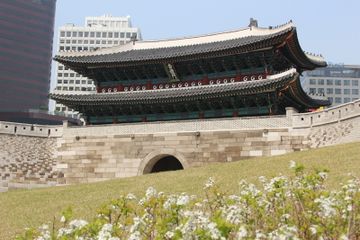서울 숭례문
| 서울 숭례문 Sungnyemun Gate, Seoul |
|
 서울 숭례문, 국가문화유산포털, 문화재청. |
|
| 대표명칭 | 서울 숭례문 |
|---|---|
| 영문명칭 | Sungnyemun Gate, Seoul |
| 한자 | 서울 崇禮門 |
| 주소 | 서울특별시 중구 세종대로 40 (남대문로4가) |
| 지정(등록) 종목 | 국보 제1호 |
| 지정(등록)일 | 1962년 12월 20일 |
| 분류 | 유적건조물/정치국방/성/성곽시설 |
| 시대 | 조선시대 |
| 수량/면적 | 1동 |
| 웹사이트 | 서울 숭례문, 국가문화유산포털, 문화재청. |
|
|
|
목차
해설문
국문
기존 국문
숭례문은 조선 태조 7년(1398)에 한양도성의 남쪽 대문으로 세워졌다. 그 후 세종 30년(1448), 성종 10년(1479), 고종 연간에 큰 수리가 있었다. 조선시대에는 매일 밤 인정(10시 무렵)에 문을 닫았다가 다음 날 아침 파루(4시 무렵)에 문을 열었는데, 이때 문루에 종을 달아 그 시간을 알렸다. 장마나 가뭄이 심할 때는 임금이 몸소 기청제와 기우제를 지내는 등 숭례문에서는 국가의 중요한 행사가 거행되곤 하였다.
석축 위에 세워진 중층 누각은 장식이 간결하고 내부 구조가 견실하여 조선 초기의 건축기법을 잘 간직하고 있다. 1907년부터 1908년 사이에는 좌우 성곽이 철거되었으며, 한국전쟁 때 피해를 입어 1961년부터 1963년 사이에 해체보수를 하였다. 2008년 2월 10일 방화 사건으로 크게 훼손되어 2013년 4월까지 복구하였으며, 이때 좌우 성곽도 함께 복원하였다.
수정 국문(2021)
서울 숭례문은 조선 태조 7년(1398)에 한양 도성의 남쪽 대문으로 세워졌다. 그 후 세종 30년(1448), 성종 10년(1479)과 고종이 왕위에 있던 시기에 크게 수리하였다. 1907년부터 1908년 사이에는 왼쪽과 오른쪽에 있던 성곽을 철거하였다. 한국전쟁이 끝난 뒤인 1953년에는 응급 복구 작업을 했고 1961년부터 1963년 사이에는 전면 해체 보수 작업을 하였다. 2008년 2월 10일 숭례문 방화 사건으로 건물 전체가 크게 훼손되어 2013년 4월까지 복구 작업을 하였다. 이때 왼쪽과 오른쪽 성곽도 함께 복원하였다.
조선 시대 한양의 출입문으로 매일 밤 인정(10시쯤)에 문을 닫았다가 다음 날 아침 파루(새벽 4시쯤)에 문을 열었는데, 문루*에 종을 달아 그 시간을 알렸다. 장마나 가뭄이 심할 때는 임금이 여기서 몸소 날이 개기를 비는 기청제나 비가 내리기를 비는 기우제를 지냈다.
숭례문은 지어진 연대를 정확히 알 수 있는 서울 성곽 중에서 제일 오래된 목조 건축물이다. 또한 석축 위에 세워진 중층 누각은 장식이 간결하고 내부 구조가 견실하여 조선 초기의 건축 기법을 잘 간직하고 있다.
- 문루: 궁문, 성문 따위의 바깥문 위에 지은 다락집
영문
- Sungnyemun Gate, Seoul
기존 영문
Sungnyemun, the South gate of Seoul, was elected in 1398. 7th year of King Taejo. founder of the Joseon Dynasty, as one of the four gates of the capital city. Major repairs were done on the gate in 1448, the 30th year of King Sejong the Great, in 1479, the 10th year of King Seongjong, and during the reign of King Gojong(reg. 1863~1907), the second to the last king of Joseon. During the Joseon period, the gate was closed around 10 p.m. and opened around 4 a.m., at which times the bell installed in the gate house tolled to proclaim the closing and the opening of the gate. At times of flood and drought the king came to the gate to preside over prayer rituals invoking fair weather and rainfall, respectively.
The two-story gate house erected atop the gate wall has sturdy internal structure and beautifully decorated early Joseon-style bracket system. Between 1907 and 1908, the city walls to the left and right of the gate were torn down by the Japanese, who had made Korea their protectorate in 1905 and exercised practically sovereign power.
The gate was damaged during the Korean War(1950~53), so from 1961 to 1963, it was taken completely apart, thoroughly repaired, and fully reassembled. In February 2008, an arsonist set fire to the gate, almost entirely destroying the roof of the gate house, to the nation's great horror. Repair was planned and carried out for five years, from 2008 to 2013, during which the city walls to the right and left of the gate were also restored.
수정 영문(2021)
Sungnyemun Gate was one of the main gates of the Seoul City Wall, which was the fortress that encircled Hanyang, the capital of the Joseon dynasty (1392-1910). Its name means "Gate of Honoring Propriety." The general public often refers to this gate as Namdaemun, meaning "South Gate," because it was the southern entrance of the capital. On top of the gate is a two-story wooden pavilion, which is the oldest wooden structural remains of the Seoul City Wall.
The gate was first built in 1398 and was renovated in 1448 and 1479. It was damaged during the Korean War (1950-1953) and was taken apart, repaired, and reassembled between 1961 and 1963. In 2008, most of the wooden pavilion atop the gate was destroyed in an arson attack. Repairs of the gate were completed in 2013.
During the Joseon period, Sungnyemun Gate closed at 10 p.m. and opened at 4 a.m. each day, and a bell in the gate pavilion was used to announce the time. The gate was also visited occasionally by the king, who presided over rituals held here during times of flood and drought.
Despite the various damages it has suffered in the past, Sungnyemun Gate remains a valuable resource in understanding the architectural design and construction techniques of the early Joseon period.
영문 해설 내용
숭례문은 조선왕조의 수도인 한양의 주위를 둘러싸고 있는 한양도성의 대문 중 하나이다. 숭례문이라는 이름은 ‘예를 숭상한다’는 의미를 가진다. 일반적으로 남대문이라고도 불리는데, 이는 이 문이 수도의 남쪽 대문이었기 때문이다. 대문 위에 세워진 중층 누각은 서울 성곽에서 가장 오래된 목조 건축물이다.
이 문은 1398년에 처음 세워졌고, 1448년과 1479년에 크게 수리되었다. 한국전쟁 당시 크게 훼손되어 1961년부터 1963년 사이에 전면 해체 보수 작업을 하였다. 2008년 방화 사건으로 건물 전체가 크게 훼손되었고, 2013년까지 복구 작업을 하였다.
조선시대에는 매일 밤 10시쯤에 문을 닫았다가 다음날 새벽 4시쯤에 열었으며, 문루에 종을 달아 그 시간을 알렸다. 장마나 가뭄이 심할 때는 임금이 여기서 몸소 제를 지냈다.
오랜 시간을 지나오며 여러 차례 피해를 입었으나, 숭례문은 조선 초기의 건축 구조와 기법을 이해할 수 있는 가치 있는 자료이다.
